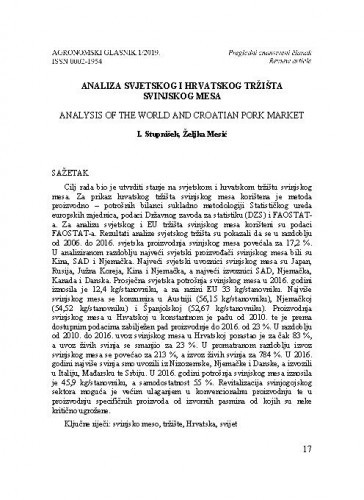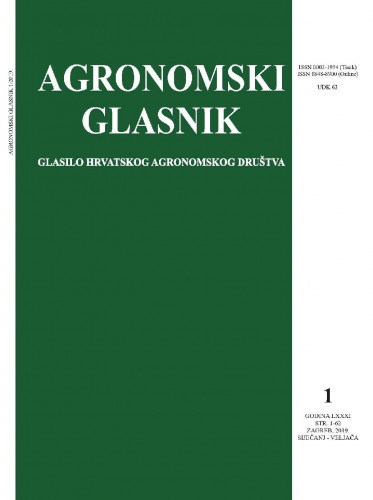Cilj rada bio je utvrditi stanje na svjetskom i hrvatskom tržištu svinjskog mesa. Za prikaz hrvatskog tržišta svinjskog mesa korištena je metoda proizvodno – potrošnih bilanci sukladno metodologiji Statističkog ureda europskih zajednica, podaci Državnog zavoda za statistiku (DZS) i FAOSTATa. Za analizu svjetskog i EU tržišta svinjskog mesa korišteni su podaci FAOSTAT-a. Rezultati analize svjetskog tržišta su pokazali da se u razdoblju od 2006. do 2016. svjetska proizvodnja svinjskog mesa povećala za 17,2 %. U analiziranom razdoblju najveći svjetski proizvođači svinjskog mesa bili su Kina, SAD i Njemačka. Najveći svjetski uvoznici svinjskog mesa su Japan, Rusija, Južna Koreja, Kina i Njemačka, a najveći izvoznici SAD, Njemačka, Kanada i Danska. Prosječna svjetska potrošnja svinjskog mesa u 2016. Godini iznosila je 12,4 kg/stanovniku, a na razini EU 33 kg/stanovniku. Najviše svinjskog mesa se konzumira u Austriji (56,15 kg/stanovniku), Njemačkoj (54,52 kg/stanovniku) i Španjolskoj (52,67 kg/stanovniku). Proizvodnja svinjskog mesa u Hrvatskoj u konstantnom je padu od 2010. te je prema dostupnim podacima zabilježen pad proizvodnje do 2016. od 23 %. U razdoblju od 2010. do 2016. uvoz svinjskog mesa u Hrvatskoj porastao je za čak 83 %, a uvoz živih svinja se smanjio za 23 %. U promatranom razdoblju izvoz svinjskog mesa se povećao za 213 %, a izvoz živih svinja za 784 %. U 2016. godini najviše svinja smo uvozili iz Nizozemske, Njemačke i Danske, a izvozili u Italiju, Mađarsku te Srbiju. U 2016. godini potrošnja svinjskog mesa iznosila je 45,9 kg/stanovniku, a samodostatnost 55 %. Revitalizacija svinjogojskog sektora moguća je većim ulaganjem u konvencionalnu proizvodnju te u proizvodnju specifičnih proizvoda od izvornih pasmina od kojih su neke kritično ugrožene.; The aim of the paper was to determine the situation on the world and Croatian market of pig meat. The method of production and consumption balance was used to show the Croatian pig meat market according to the methodology of the Statistical Office of the European Communities, the data of the C entral B ureau o f S tatistics a nd F AOSTAT. F AOSTAT d ata w as u sed t o analyze the world and EU pig meat market. The results of the world market analysis showed that in the period from 2006 to 2016 world meat production increased by 17.2 %. In the analyzed period, the world's largest pig meat producers were China, the USA and Germany. The world's largest importers of pork are Japan, Russia, South Korea, China and Germany, and the largest exporters are USA, Germany, Canada and Denmark. The average world consumption of pork in 2016 was 12.4 kg per capita and at EU level 33 kg per capita. Most pork meat is consumed in Austria (56.15 kg/capita), Germany (54.52 kg/capita) and Spain (52.67 kg/capita). Pig meat production in Croatiahas been steadily declining since 2010, and according to available data, production fell 23 % by 2016. Between 2010 and 2016, imports of pork in Croatia increased 83 %, while imports of live pigs decreased by 23 %. In the observed period, exports of pig meat increased by 213 % and exports of live pigs increased 784 %. In 2016 Croatia imported the most pigs from the Netherlands, Germany and Denmark and exported to Italy, Hungary and Serbia. In 2016 consumption of pig meat was 45.9 kg/per capita and self-sufficiency was 55 %. Revitalization of the pig meat sector is possible by investing more in conventional production and in the specific products from domestic breeds, some of which are critically endangered.
Sažetak

 Agronomski glasnik : glasilo Hrvatskog agronomskog društva : 81,1(2019) / glavni i odgovorni urednik, editor-in-chief Ivo Miljković.
Agronomski glasnik : glasilo Hrvatskog agronomskog društva : 81,1(2019) / glavni i odgovorni urednik, editor-in-chief Ivo Miljković.